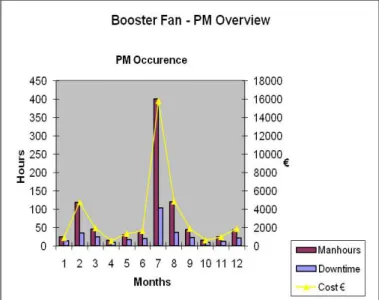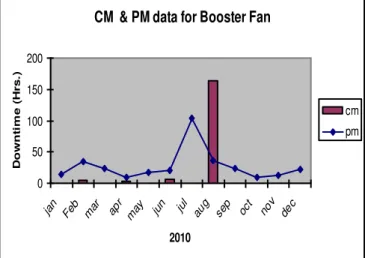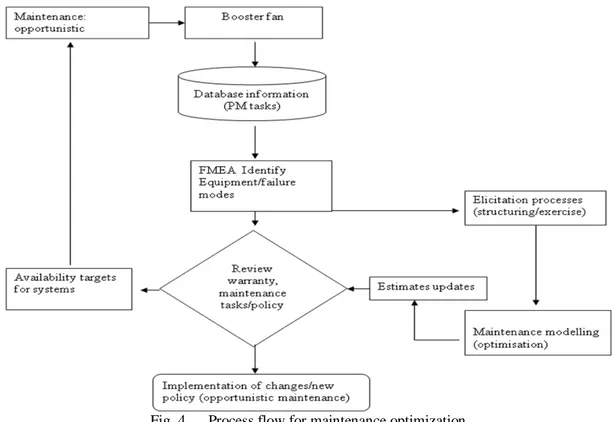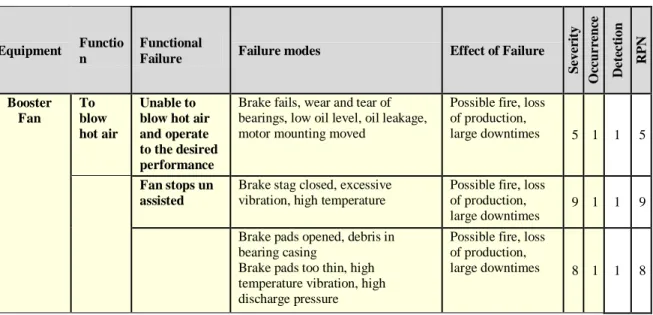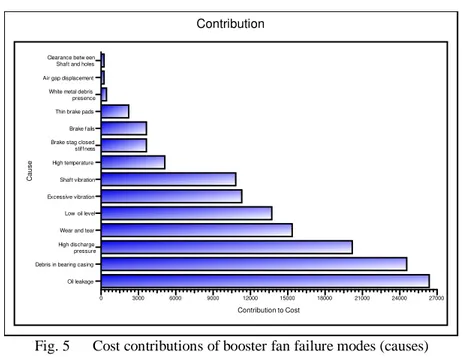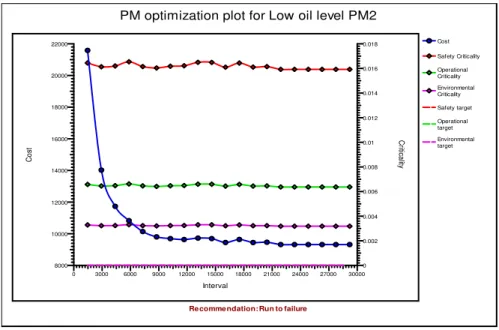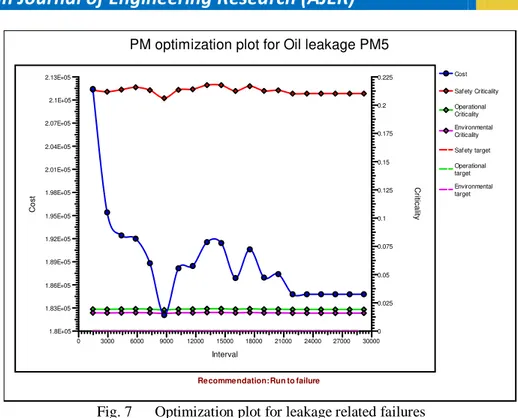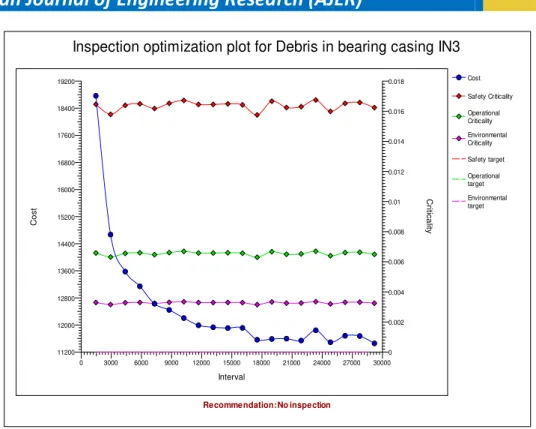American Journal of Engineering Research (AJER)
e-ISSN : 2320-0847 p-ISSN : 2320-0936
Volume-03, Issue-04, pp-01-10
www.ajer.org
Research Paper Open Access
Opportunistic maintenance and adaptation of warranty
maintenance tasks for Power Plant equipment
B.M. Alkali
1and P. McGibney
21
Department of Mechanical, Electrical and Environmental Engineering, Glasgow Caledonian University, Cowcaddens Road, G4 0BA, Scotland, United Kingdom
2
K-MAC Facilities Management Services, Shannon Co Clare, Ireland
Abstract: - This paper makes a link between opportunistic maintenance literature and warranty analysis of a power plant. A new plant warranty maintenance tasks are observed over a two year period. The main aim is to see how opportunistic maintenance could be incorporated when the warranty period has elapsed. The paper examine the warranty period maintenance task list and propose adequate methods for assessing opportunistic maintenance as a preventive maintenance task in order to ensure reliability and availability of the plant equipment. Statistical approach is used to give an insight to the plant equipment status and a modeling approach is proposed to also assess maintenance information defined by experts in the context of actual operating regimes. This study focuses on the power plant‟s critical equipment. Failure Mode and Effect Analysis (FMEA) is conducted on the power plant Booster Fans. This gives an insight about equipment failure mode patterns and maintenance requirements. A simulation example is presented based in the failure modes results obtained and a graphical display of optimum preventive maintenance schedule cost curves is also presented.
Keywords: - opportunistic maintenance, warranty, FMEA, preventive maintenance, optimization
I. INTRODUCTION
In this paper a power generating plant that has three generating units is considered. New plant equipment is built into an existing power plant and it is in the view of the asset owner and plant maintenance manager to consider incorporating opportunistic maintenance to the existing plant maintenance tasks when a window of opportunity arises after the warranty period has elapsed. A full assessment of the plant maintenance process would in this case require a review for best practise to „fit in‟ with the plant maintenance policy. The main challenge is to focus on the maintenance tasks of both the new equipment and existing plant systems. However emphasis will be focused on critical equipments in the first instance. Relevant maintenance tasks are needed to be identified and added to the plant register and hence computerised maintenance management systems. Initial investigation show that all the new plant equipment maintenance tasks derived from the original equipment manufacturer (OEM) manual and expert opinion were elicited before listing them on the power plant register. This paper presents a new development and builds upon previous work conducted on the conversion of the warranty tasks by Alkali and McGibney [1]. The focus here is to see how opportunistic maintenance could be utilised. The main reasons for driving the use of opportunistic maintenance is that when other equipment in the plant are required to generate power and are out of service then the critical equipment in the plant can be maintained without further major loss of power, and redundancy. However, it is possible that opportunities will be left unused, for example because of the need to generate full production depending on the demand in the electricity market.
maintenance contract is presented by We et al. [4]. A review of maintenance models and how the performance of a repairable system under maintenance and repair contracts can be optimised is presented in Lugtigheid, et
al.[5]. The planning of maintenance problem consists of a sequence of decision points over time, whereby
decisions are made to repair or replace a equipment based on its condition. This problem can be further complicated by prevailing failure characteristics, and downtime costs. An optimal replacement-repair policy for multi-state deteriorating products under renewing free replacement warranty [6] show how repair and replacement decisions are made for warranted product subject to deterioration. [7] Discuss the repair and replacement decisions for warranted product under Markov deterioration. Extensive information about optimizing the repair and replacement of systems under warranty contracts is also discussed [8-12].
In this study, the idea of equipment giving off signs of defects, failure is likely to occur within a short interval of time. The decision maker could envisage bringing a fixed preventive maintenance time forward. It then makes sense to use opportunistic maintenance on other equipment if there are available resources, and also if one has information on the status of the equipment through condition monitoring data. A study by Coolen et
al.,[13] consider the opportunity-based age replacement (OAR) of a unit upon failure and upon the first
opportunity after reaching a predetermined threshold age, whichever occurs first. They also showed that the method can take extra information into account appropriately, and also revealed that on some occasions counter-intuitive results may appear which is shown and explained by the optimality criterion. An integrated approach into a comprehensive maintenance strategy of a power station is also discussed in MacIntyre, et al., [14], they also mentioned the types of mechanical problems experienced with power plant operation. A multi-component inspection system model based upon the delay time concept that incorporates the case of opportunistic inspection at failures is discussed by Wang and Christer [15]. There are a vast majority of literature on opportunistic maintenance and warranty models on complex systems subject to age replacement, renewal process, and repair amongst others. The theory is not new, however the application to real systems seems to be scarce.
1.1 Power Plant Process Description
The power Plant considered in this investigation agreed a contract on a full service warranty period of two years from the end of the plant „reliability test run‟. This is when the plant is operated for ninety days continuously without any problems. As part of the warranty agreement, the vendor has given over the full operation and maintenance manuals (database) to the plant maintenance department. The plant management
contract must ensure they „carry out and record‟ the required maintenance tasks, as set out by vendor in order to
retain the warranty status for the plant. These maintenance tasks list make up the foundation for the future maintenance schedule for the Plant. This investigation focuses particularly on the Booster Fan. The data selected in the study are man-hours, downtime, and cost for each of the PM‟s associated with each area of the plant. The area for the Booster fan is broken down into the following: 6 sub systems (the fans & fan bearings, motor and motor bearings, lubrication system, Variable Inlet Vanes coupling, brake and Control Vane Actuator). A summary of one year data for the whole Booster downtime, cost and man-hours required following a failure and schedule maintenance is displayed on the graph in Fig. 1 below.
CM & PM data for Booster Fan
0 50 100 150 200
jan Feb mar apr may jun jul aug sep oct nov dec
2010
D
ow
nt
im
e
(
H
r
s
.)
cm
pm
The downtime following corrective maintenance (CM) and preventive maintenance (PM) activities on the booster fan is plotted on a graph in Fig. 2.
Fig. 2 Booster Fan CM and PM downtime
However, the questions here is how much man hours and resources can be made available to consider opportunistic maintenance and do preventive maintenance task and also the costing associated to all level of staff if required. Better planning and the use of resources is also possible from the graphs presented rather than looking at database formatted data. The graph highlights maintenance scheduling issues on the booster fan in the plant and shows the annual PM and CM downtime. It is clear to see that a major failure occurred almost
immediately after the PM‟s activities carried out. This subsequently led to the following questions: Should the PM with strong grouping be more spread out evenly across the year?
Should the main PM‟s be done opportunistically when inspections are conducted during an outage/overhaul
where better time and attention can be given to the task?
Are the competing failure modes directly linked to the group of PM carried out just prior to the failure?
The downtime labor profile following CM, PM and inspections on the booster fan are presented in Fig. 3. Note that the frequency of inspections is more compared to the PM activities. However, the large inspection times are due to the warranty tasks specified by the OEM.
Labor Profile for All Labor
Corrective PM Inspection
0 8760 17520 26280 35040 43800 52560 61320 70080 78840 87600 Profile Time
0 2 4 6 8 10 12 14 16
A
ct
iv
e
T
im
e
Fig. 3 Labor downtime profile following CM, PM and inspection
II. POWER PLANT MAINTENANCE POLICY
The maintenance policies considered at the power plant in this investigation are of a number of different types: Overhauls are carried out at fixed intervals, generally giving a system that is as good as new.
Opportunistic maintenance is not considered frequently when other parts of the plant system have gone down or are not required.
Opportunistic maintenance may be preventive or corrective, but the logistic burden involve give preference to adequate PM where possible, and hence restoring the system to as near as possible to “good as
new”. In this paper we attempt to model the plant process and incorporate opportunistic maintenance within the
maintenance framework. The diagram in Fig. 4 present a process flow for the preventive maintenance policy review process and modeling to support decision on optimum maintenance policy. An opportunity arises if failure of some other parts of the equipment allows the component or part in question to be replaced. An example is presented regarding the loss of power supply from a generating plant which may give an opportunity to perform some preventive replacement on one or more components that are not performing reasonably well or faulty. The identification of critical equipment and relevant data information from databases are sort in the first instance. FMEA approach is considered to identify possible failure modes that could be apparent or hidden to the maintainer and a review of the warranty tasks that are obvious specified by the OEM. Elicitation from expert is vital although subjective, Mazzuchi, et al., [16] and O'Hagan [17] discuss the importance of elicitation and it relevance in maintenance optimization and practical applications respectively.
Fig. 4 Process flow for maintenance optimization
A practical review to the framework of warranty cost management and warranty cost analysis for multi-component systems is discussed by Diaz, et al.[18] and Park and Pham [12] respectively. Wu, et al., [4] demonstrate how general periodic preventive maintenance policies can be incorporated into warranty contracts for system‟s aging losses. The decision for implementation of new maintenance policy need to be justified from the maintenance modeling results obtained available resources (such as downtimes and man-hours), event severity and environmental targets play a significant role in supporting the decision making process on maintenance policy.
III. FMEA AND PREVENTIVE MAINTENANCE REVIEW
1. Carry out a „PM Review‟ through expert‟s elicitation with all Front Line Managers (FLM) and careful consultation with the plant maintenance engineers to preserve irrelevant tasks and document all reasons. 2. Conduct Failure Mode and Effects Analysis to identify any potential failure modes and ensuring all the
valid maintenance tasks are applied to ensure safe and reliable operation of the plant in question.
The following steps are considered in our initial analysis on the selections of maintenance tasks from both
database and expert‟s opinion:
1. Obtain and agree the database working version to use 2. Divide database activities into three sections
3. Ensure the number of tasks across the three units are equal and amend with expert‟s advice 4. Restore all obsolete tasks
5. Restore tasks that are no longer essential 6. Repeat steps 3-5 on a regular basis
7. Agree and confirm the database with the „Master‟ listing for the maintenance tasks 8. Assign each of the tasks to required maintenance task group.
These list are non exhaustive and also form the basis for the eventual maintenance tasks uploaded onto the CMMS. The critical equipment considered in this study is the Booster fan. The Booster fan has 42 maintenance tasks and these tasks are similar in all the other fans in the other generating units. In order to have a better insight of the failure behavior and to justify the need for opportunistic maintenance we conducted failure mode and effect analysis (FMEA) on the booster fan to assess the maintenance requirements.
3.1 Failure Mode and Effect Analysis
The FMEA is to identify the relevant failure modes and propose appropriate maintenance task requirements. The results obtained from the FMEA analysis of the Booster fan is presented in Table 1. The risk priority number (RPN) values following the identified failure modes give a low value. These results are not surprising as the booster fan is fairly new. The risk priority number is the product of the severity, occurrence and detection, this gives an indication on the effect it has to the failure caused by the selected failure modes.
Table 1. Booster Fan FMEA and RPN results
The graph in Fig, 5 below show the cost contribution of failure modes (causes) toward the effects it has on the booster fan. The Booster fan failure modes identified such as oil leakage, white metal debris in the bearings and high discharge pressure contribute significantly to the cost of failure of the fans.
Equipment Functio
n
Functional
Failure Failure modes Effect of Failure
S
eve
ri
ty
O
cc
u
rr
en
ce
D
et
ec
ti
on
R
P
N
Booster Fan
To blow hot air
Unable to blow hot air and operate to the desired performance
Brake fails, wear and tear of bearings, low oil level, oil leakage, motor mounting moved
Possible fire, loss of production,
large downtimes 5 1 1 5
Fan stops un assisted
Brake stag closed, excessive vibration, high temperature
Possible fire, loss of production, large downtimes
9 1 1 9
Brake pads opened, debris in bearing casing
Brake pads too thin, high temperature vibration, high discharge pressure
Possible fire, loss of production,
Contribution
0 3000 6000 9000 12000 15000 18000 21000 24000 27000 Contribution to Cost
Oil leakage Debris in bearing casing High discharge pressure Wear and tear Low oil level Excessive vibration Shaft vibration High temperature Brake stag closed stiffness Brake fails Thin brake pads White metal debris presence Air gap displacement Clearance betw een Shaft and holes
C
a
u
s
e
Fig. 5 Cost contributions of booster fan failure modes (causes)
The FMEA resulted in a better understanding of the Booster fan failure modes. The outcome and proposed task highlighted how good a detection system could be on site. The result is compared to the existing
maintenance listing. We observed that the plant warranty on inspections, PM and CM are deemed „excessive‟ to
ensure reliability during the two year period. The analysis has given some insight to the equipment behavior and the following benefits of the FMEA outcomes obtained are:
Improved „awareness‟ of the Booster fan –components and operation. Increases chance of early problem detection and prevention.
Reassures Maintenance that all possible failure is catered for through the existing maintenance schedule. Highlighted areas for further analysis
Created better teamwork between operations and maintenance teams.
The proposed proactive maintenance tasks are; PM to include visual inspection of oil levels
PM to include visual inspection of vibration noise and temperature alarm checks
PM to include visual monitoring of white metal in bearing and ensure they remain clean from debris Ensure spares are in stock and develop protocols for staff to ensure that adequate maintenance task are
conducted
These proposed tasks can be conducted whenever there is a window of opportunity to use opportunistic maintenance for the proposed PM task. Bedford and Alkali [19] propose models for competing risk involving censoring through opportunistic maintenance, in the paper they address competing risk statistical estimation problems which are a common concern in much of the maintenance literature, and focus attention on non-age-related information available to maintenance managers.
IV. MAINTENANCE OPTIMIZATION
We consider the situation where each time a booster fan fails, it is repaired and returned to full operational condition some components can be replaced and repaired. For a preliminary analysis, we assume that repair times are negligible for some task. Suppose T1, T2, T3,…are the times to successive failures of the
booster fan components, and Xi = Ti Ti1 is the time between failure i 1 and failure i where T0 = 0. The Ti and Xi are random variables and ti and xi are defined to be their corresponding realized values. The fundamental model is then the non-homogeneous Poisson process (NHPP). Under the NHPP model the Xi are said to be neither independent nor identically distributed and can be defined by the intensity function of a stochastic point process.
A comprehensive review of maintenance optimisation models and analysis is discussed by Dekker [20]. A subjective approach of maintenance policy based on costs and downtimes after non-renewing warranty contract is discussed by Jung, et al., [21]. Other cost based models with associated maintenance warranty contracts are demonstrated by Diaz, et al., [18] and Park and Pham [12].
In this paper the booster fan has a failure time distribution F(t) with finite mean and a density f(t). Then failure rate is given as
) 1 ( ) ( / ) ( )
(t f t F t
r
and the cumulative hazard is give as;
) 2 ( ) ( )
(t
0tr y dyR
which has a relation
F
(
t
)
1
F
(
t
)
, whereF
(
t
)
exp{
R
(
t
)}
.It is further assumed that the failure rate r(t) is continuous, strictly increasing, and remains undisturbed by minimal repair. If T=∞, then the survival distribution of the time between successive failure is given by
) 3 ( ] ) ( ) ( exp[ ) ( 0
tp t p x r x dx
F
The cost of the failure process is governed in the interval (0, t), which corresponds to the period of observation. With the renewal reward theorem the expected cost in operating a unit over the specified interval is envisaged. The expected cost rate in this case can be obtained and the optimal T* which would minimizes the PM cost.
4.1 Simulation example
We now present comparative simulations of the NHPP model to illustrate the characteristic of the failure modes obtained from our FMEA using RCMCost Availability Workbench Software. For the sake of comparison, 4 prominent failure modes which include; oil leakage, low level oil, excessive vibration and white metal debris respectively are considered as the cost contributions attributed by them are somewhat significant. The failure times are simulated from this model as follows; for the first case of failure caused by oil leakage, we assume that the underlying lifetime distribution is Weibull with shape parameter 1.3 and scale parameter 1. We run simulation by generating random sample from a weibull distribution. Preventive maintenance optimization plot in Fig. 6 suggest run to failure for low oil level related failures. The safety, operational and environmental criticality target are very constant over time. However the cost curve becomes almost flat from 8,990 operating hours and our simulation results suggest run to failure for low level oil related failures.
Recommendation: Run to failure
PM optimization plot for Low oil level PM2
Cost Safety Criticality Operational Criticality Environmental Criticality Safety target Operational target Environmental target 0 0.002 0.004 0.006 0.008 0.01 0.012 0.014 0.016 0.018 C rit ic a lity
0 3000 6000 9000 12000 15000 18000 21000 24000 27000 30000 Interval 8000 10000 12000 14000 16000 18000 20000 22000 C o st
Fig. 6. PM optimization of oil level related failures
Recommendation: Run to failure
PM optimization plot for Oil leakage PM5
Cost Safety Criticality Operational Criticality Environmental Criticality Safety target Operational target Environmental target 0 0.025 0.05 0.075 0.1 0.125 0.15 0.175 0.2 0.225 C rit ic a lit y
0 3000 6000 9000 12000 15000 18000 21000 24000 27000 30000
Interval 1.8E+05 1.83E+05 1.86E+05 1.89E+05 1.92E+05 1.95E+05 1.98E+05 2.01E+05 2.04E+05 2.07E+05 2.1E+05 2.13E+05 C o s t
Fig. 7 Optimization plot for leakage related failures
The model fit recommend run to failure. We further explore and fitted the simulation model to failure resulting from excessive vibration related failure modes in Fig. 8, and the cost curve recommend run to failure. The safety criticality plot increases super linearly and has a bleep is observed at 13,000 operating hours interval and stabilizes at 19,000. The operational and environmental criticality patterns are very similar and increases in a predictable fashion and becomes constant from 15,000 operating hours.
Recommendation: Run to failure
PM optimization plot for Excessive vibration PM1
Cost Safety Criticality Operational Criticality Environmental Criticality Safety target Operational target Environmental target 0 0.0008 0.0016 0.0024 0.0032 0.004 0.0048 0.0056 0.0064 C rit ic a lity
0 3000 6000 9000 12000 15000 18000 21000 24000 27000 30000 Interval 0 20000 40000 60000 80000 1E+05 1.2E+05 C o st
Fig. 8. PM optimization for vibration related failures
Recommendation: No inspection
Inspection optimization plot for Debris in bearing casing IN3
Cost Safety Criticality Operational Criticality Environmental Criticality Safety target Operational target Environmental target
0 0.002 0.004 0.006 0.008 0.01 0.012 0.014 0.016 0.018
C
rit
ic
a
lit
y
0 3000 6000 9000 12000 15000 18000 21000 24000 27000 30000
Interval
11200 12000 12800 13600 14400 15200 16000 16800 17600 18400 19200
C
o
s
t
Fig. 9 Optimum inspection for white metal debris related failures
In practice, when there are multiple components in a system, the rescheduling of the inspections following preventive maintenance a defective component would not cause inspections to become unsynchronized; it would just mean some components would continue to be inspected for longer. Although, one could imagine a policy in which if one component is preventively replaced at inspection, the inspections of all components would be rescheduled. This justified adaptation of opportunistic maintenance as an option to consider by asset managers.
V. CONCLUSION
In this paper a new plant under warranty maintenance preventive maintenance task is considered. The paper focuses on Booster fan and a comprehensive FMEA is conducted on the selected critical equipment and critical failure modes are identified. Opportunistic maintenance is envisaged and critical appraisal of the literature is linked with the warranty maintenance task. A non-homogenous poison process model is considered within a simulation framework and adequate candidate distributions are selected. The Booster fan PM optimization results show the expected cost per unit time following failures caused by the critical failure modes. To place these result in the context of the power plant we have been studying, it should be acknowledged that the booster fans are complex pieces of equipment embedded in a more complex system.
The maintenance opportunities are determined largely by the upstream failures in the boiler and the turbine. However these opportunities can be shared in the same generating unit and since manpower is limited in the plant a choice has to be made about which PM task to prioritize. Hence the PM times are linked across
different equipment, and not all opportunities will be taken because a “better” opportunity will be available
elsewhere. The PM optimization graphical presentation gives an insight to the PM process and highlighted the safety, operational and environmental criticality. Downtimes and man-hours are also associated with the cost of PM schedules. Cost has been the main significant factor for all maintenance scheduling problem. Modeling the PM and failure process will in no doubt support decision on optimal cost effective maintenance strategy and hence allow the decision maker to adapt opportunistic maintenance where necessary. It is important to note that results from this paper led to changes in maintenance policy when the warranty period has elapsed.
REFERENCES
[1] B. M Alkali, and P. McGibney. The Analysis and Conversion of Warranty Maintenance tasks for a
Power Plant. Advances in Safety, Reliability and Risk Management, ESREL 2011 Confrence, Troyes,
France 18-22 September 2011; The Netherland, CRC Press Taylor and Francis: 508.ISBN 978-0-415-68379-1
[2] T. Dang. Integration of power plant information system with business information system in the open electricity market: challenges and solutions. 2007; 5th Ieee International Conference on Industrial
[3] J.A Chen,Y. H Chien. Renewing warranty and preventive maintenance for products with failure penalty post-warranty. Quality and Reliability Engineering International 23(1), 2007, 107-121.
[4] J. Wu, M. Xie, T. S. Ng. On a general periodic preventive maintenance policy incorporating warranty contracts and system ageing losses. International Journal of Production Economics, 129(1), 2011, 102-110.
[5] D. Lugtigheid, A. K. S Jardine, and X. Jiang . Optimizing the performance of a repairable system under a maintenance and repair contract. Quality and Reliability Engineering International, 23(8), 2007, 943-960.
[6] H. Vahdani, S. Chukova, H. Mahlooji. On optimal replacement-repair policy for multi-state deteriorating products under renewing free replacement warranty." Computers & Mathematics with Applications,
61(4), 2011, 840-850.
[7] Y. Pan , M. U. Thomas. Repair and Replacement Decisions for Warranted Products Under Markov Deterioration. IEEE Transactions on Reliability, 59(2), 2010, 368-373.
[8] G. M. Jung and D. H. Park. Optimal maintenance policies during the post-warranty period. Reliability
Engineering & System Safety, 82(2):2003, 173-185.
[9] C. S. Kim, I. Djamaludin, D. N. P. Murthy. Warranty and discrete preventive maintenance. Reliability
Engineering & System Safety, 84(3): 2004, 301-309.
[10] R. Pascual and J. H. Ortega. Optimal replacement and overhaul decisions with imperfect maintenance and warranty contracts. Reliability Engineering & System Safety, 91(2): 2006, 241-248.
[11] A. Rangan and S. Khajoui. Optimal system design based on burn in, warranty and maintenance.
Proceedings of the 1st RFID Eurasia Conference 2007: 149-153.
[12] M. Park and H. Pham. Warranty Cost Analyses Using Quasi-Renewal Processes for Multicomponent Systems. IEEE Transactions on Systems Man and Cybernetics Part a-Systems and Humans, 40(6):2010 1329-1340.
[13] P. Coolen, F. P. A. Coolen and S. C. Shaw. Nonparametric adaptive opportunity-based age replacement strategies. Journal of the Operational Research Society, 57, 2006, 63-81.
[14] J. MacIntyre, D. Stanfield, P. Allot, and M. Harris. Integrated maintenance strategy for the Babcock 10E Coal Mill 1st IEE/ IMechE International Conference on Power Station Maintenance - Profitability
through Reliability 1998; 452: 84-89.
[15] W. Wang, and A. H. Christer. Solution algorithms for a nonhomogeneous multi-component inspection model, Computers & Operations Research 2003; 30: 19-34.
[16] T. A. Mazzuchi, R. Dekker, J. R. van Dorp,and J. M. van Noortwijik JM. Elicitation and use of expert judgment for maintenance optimization. Proceedings of the World Congress on Expert Systems: 1991; 888.
[17] A. O'Hagan. Eliciting expert beliefs in substantial practical applications. Journal of the Royal Statistical
Society Series D-the Statistician, 47(1),1998, 21-35.
[18] V. G. Diaz, M. L. Campos, J. F. Fernandez, and A. C. Marquez. Warranty cost models state-of-art: A practical review to the framework of warranty cost management. Reliability, Risk and Safety: Theory and
Applications, Vols 1-3: 2010, 2051-2059. ISBN 978-0-415-55509-8.
[19] T. Bedford, and B. M. Alkali. Competing Risks and Opportunistic Informative Maintenance. IMechE Part O: Journal of Risk and Reliability, 223, 2010, 363-372. DOI: 10.1243/1748006XJRR242
[20] R. Dekker. Applications of maintenance optimization models: A review and analysis. Reliability
Engineering & System Safety, 51(3),1996, 229-240.
